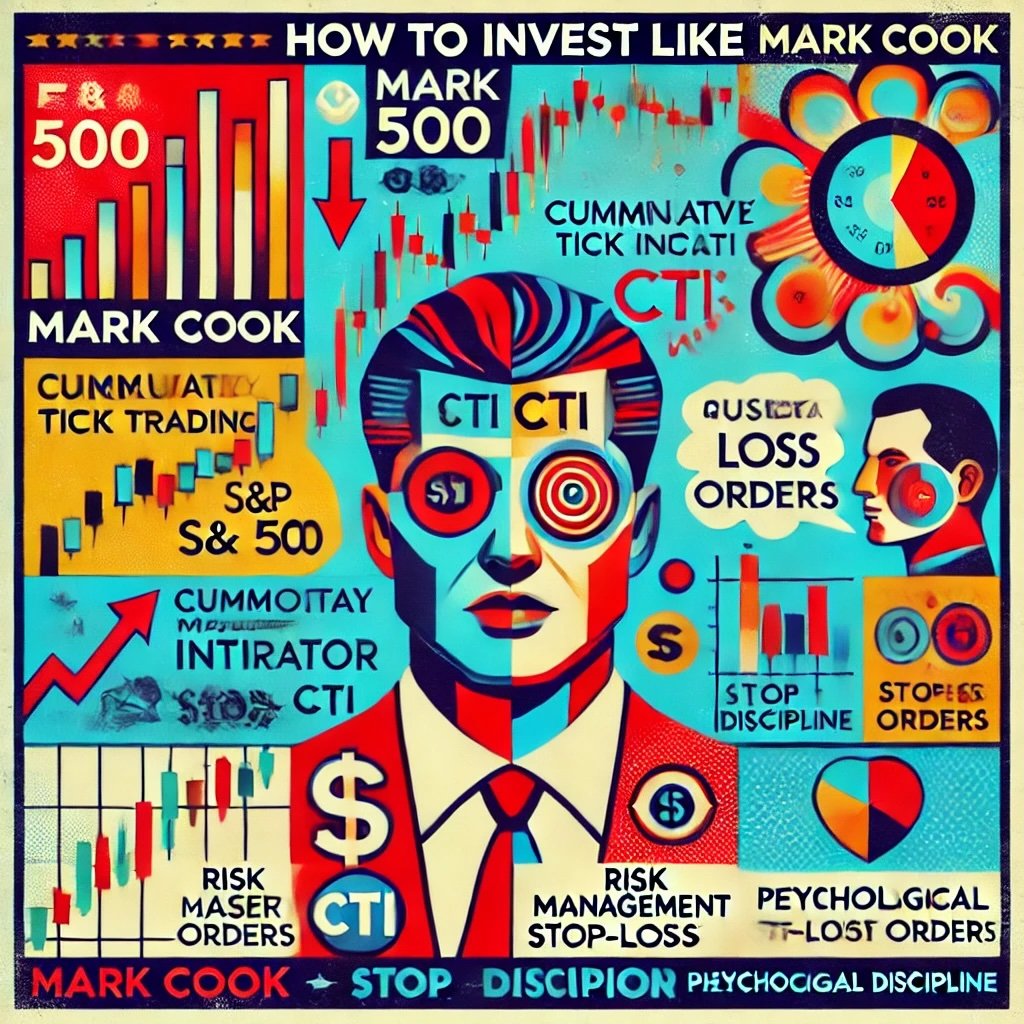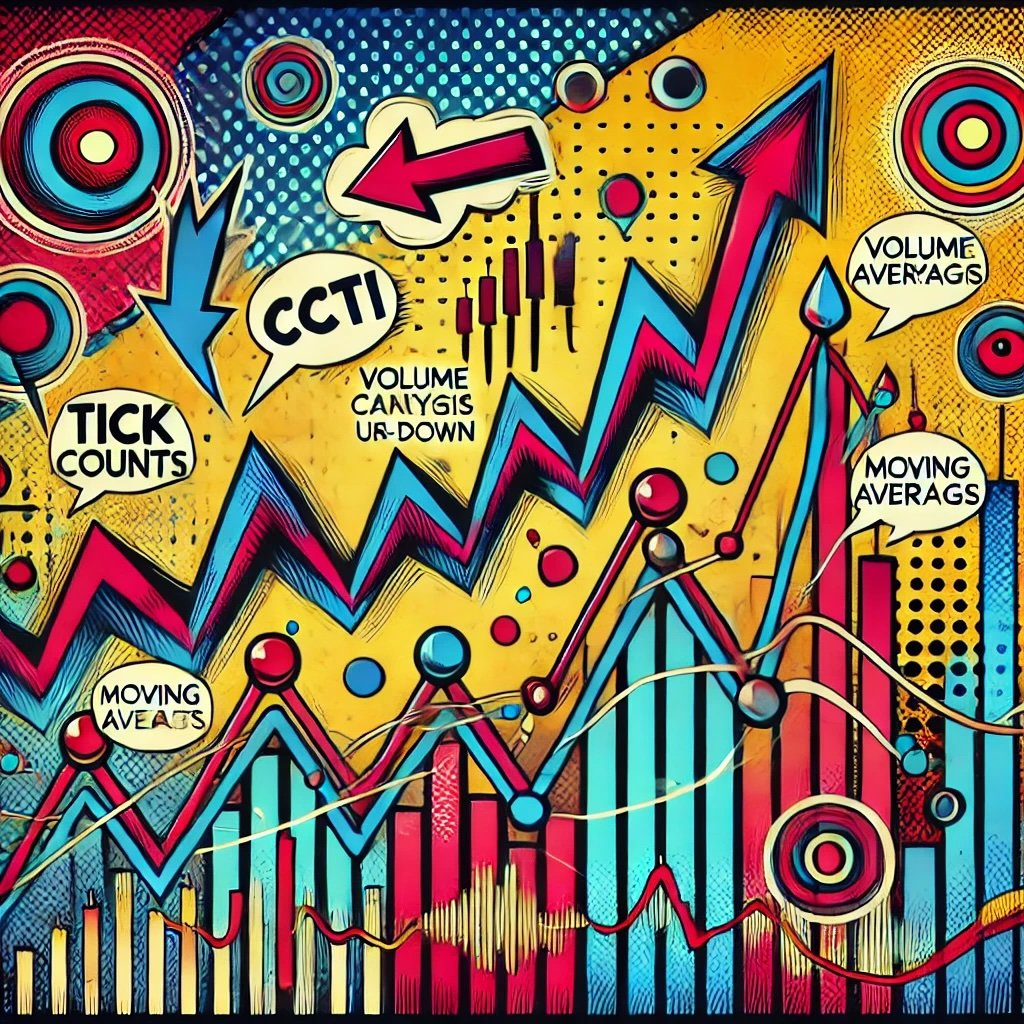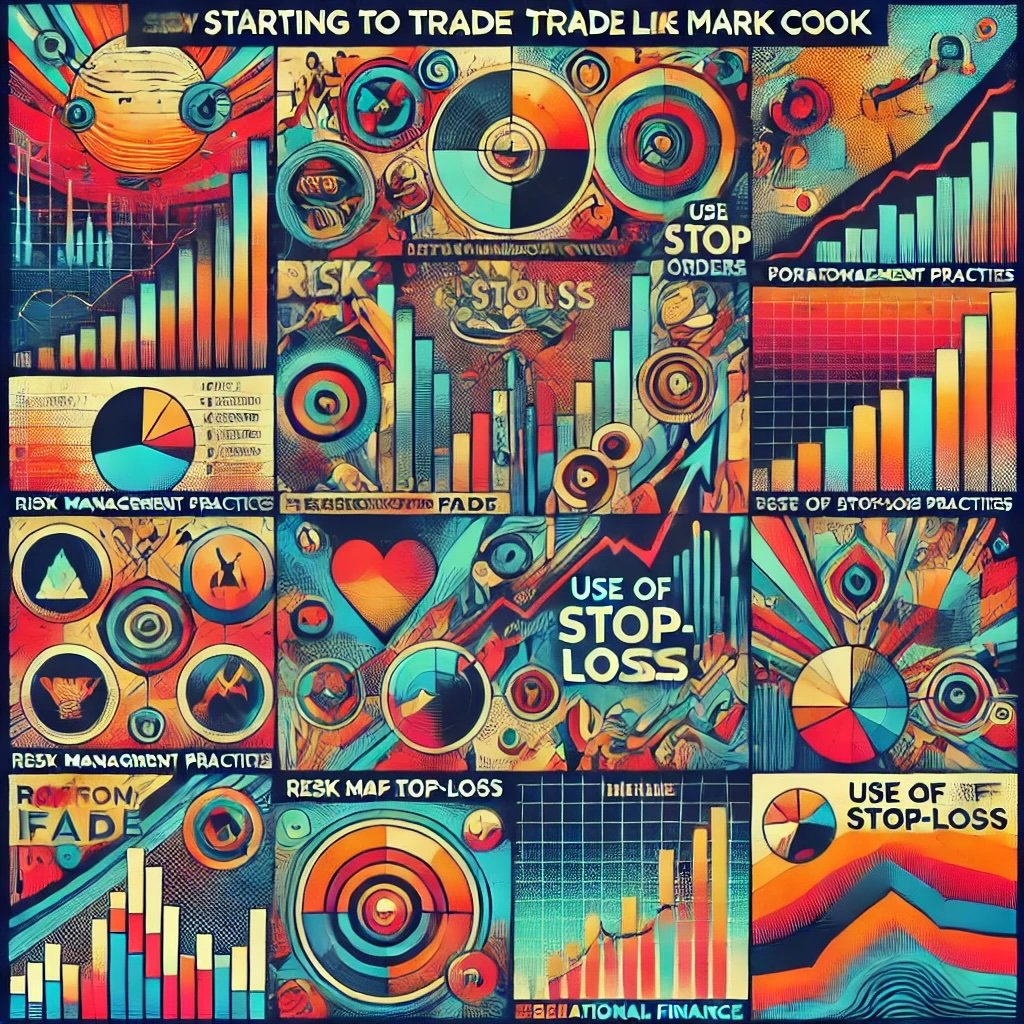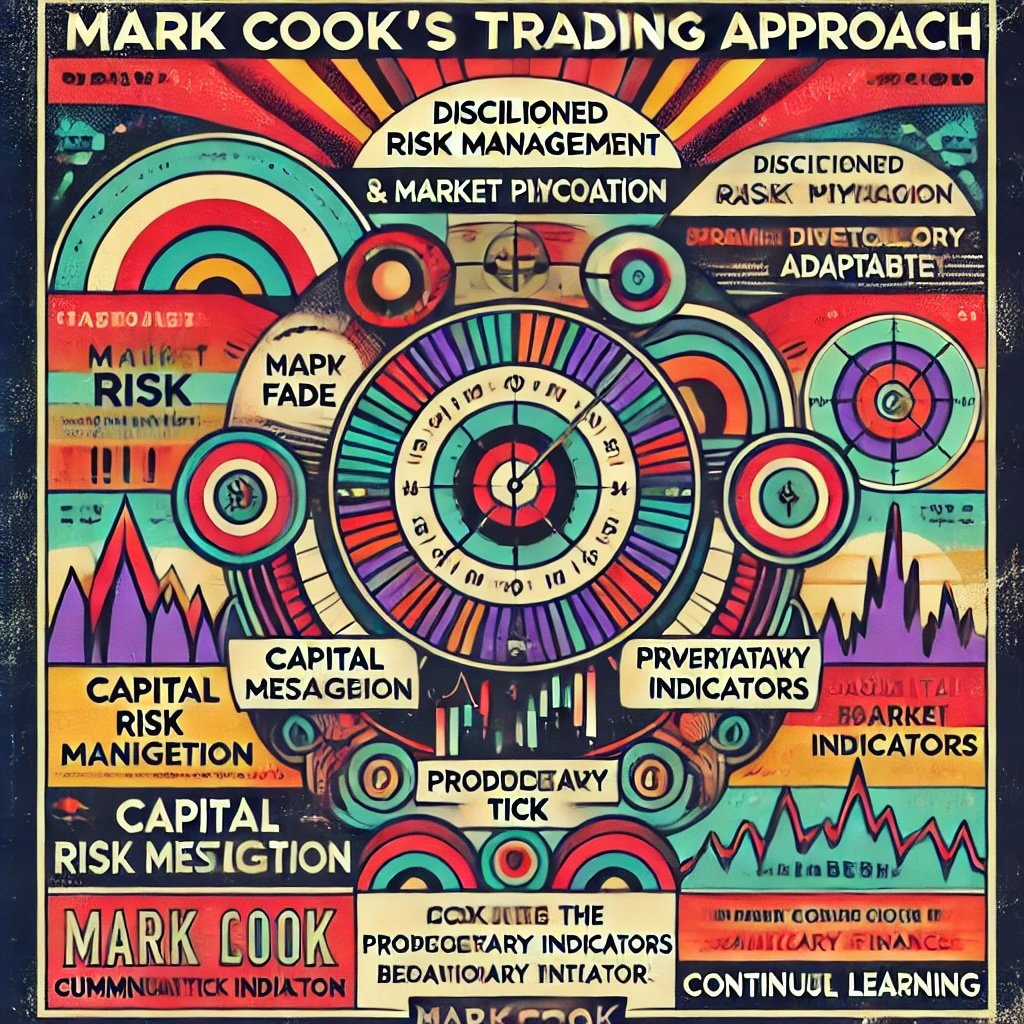Investing like a champion isn’t just about picking the right stocks—it’s about mastering the art of timing, managing risks, and maintaining unwavering discipline. Mark Cook, a top S&P 500 trader and U.S. Investing Champion, embodies these qualities through his meticulous strategies and profound market insights. In this comprehensive guide, we’ll delve into Mark Cook’s journey, explore his core trading principles, and uncover the strategies that have propelled him to success in the competitive arena of S&P 500 trading.
source: Stuart McPhee on YouTube
Mark Cook: A Luminary in S&P 500 Trading
Mark Cook has carved out a prestigious reputation in the world of trading, particularly with his focus on the S&P 500 index. His journey from humble beginnings to becoming a celebrated trader and U.S. Investing Champion is both inspiring and instructive. Cook’s success isn’t a mere stroke of luck; it’s the result of a well-honed trading philosophy and a disciplined management style that many aspiring traders can learn from.

Understanding His Trading Philosophy and Management Style
Cook’s trading philosophy centers around precision, risk management, and leveraging market indicators to make informed decisions. His management style is characterized by strict adherence to his strategies, continuous learning, and the ability to adapt to changing market conditions. By blending technical analysis with a deep understanding of market psychology, Cook has developed a robust approach that consistently yields impressive results.
Let’s explore Mark Cook’s trading strategies and the principles behind his success. Whether you’re an experienced trader looking to refine your approach or a novice seeking to understand the fundamentals of successful trading, Cook’s methodologies offer valuable insights. We’ll break down his strategies, examine his risk management techniques, and provide practical steps to help you emulate his success in trading the S&P 500.

Who is Mark Cook?
Background and Early Life of Mark Cook
Mark Cook’s journey into the financial markets began in his early years, where his fascination with numbers and patterns laid the foundation for his future career. Growing up in a modest household, Cook developed a strong work ethic and a keen interest in economics and finance. His academic pursuits in these fields further solidified his understanding of market dynamics and investment principles.
His Journey from Humble Beginnings to Becoming a Successful Trader
Starting as a junior analyst at a small brokerage firm, Cook quickly demonstrated his aptitude for identifying market trends and making strategic trades. His dedication and analytical skills led him to rise through the ranks, eventually taking on more significant roles that allowed him to influence trading strategies and decisions. Cook’s relentless pursuit of knowledge and his ability to remain calm under pressure were instrumental in his ascent to becoming a top trader.
Cook founded his own trading firm, focusing exclusively on the S&P 500 index. His approach was unconventional yet highly effective, blending technical analysis with a nuanced understanding of market psychology. This unique methodology set him apart from his peers and laid the groundwork for his subsequent achievements.
Key Achievements, Including His Victory in the U.S. Investing Championship
Mark Cook’s most notable achievement came when he won the U.S. Investing Championship, a prestigious competition that pits top traders against each other in a battle of strategy and skill. Cook’s victory was a testament to his disciplined approach and his ability to consistently outperform the market.
Other Key Achievements:
- Consistent High Returns: Cook has consistently delivered impressive returns on his trades, often outperforming major market indices.
- Authoring Influential Publications: He has penned several articles and books on trading strategies, sharing his insights with a broader audience.
- Educational Contributions: Through seminars, webinars, and mentorship programs, Cook has educated countless aspiring traders, helping them develop their own successful strategies.
- Recognition in Financial Media: Regularly featured in financial publications and media outlets, Cook continues to influence and inspire the trading community.

Core Principles of Mark Cook’s Trading Strategy
Mark Cook’s trading strategy is built upon a solid foundation of core principles that guide his decision-making process. These principles ensure that his trading remains disciplined, risk-managed, and adaptable to changing market conditions.
S&P 500 Focus: Why Cook Concentrated on the S&P 500 Index for His Trading
Understanding the S&P 500: The S&P 500 index represents 500 of the largest publicly traded companies in the United States, covering a broad spectrum of industries. This diversity makes it a robust indicator of the overall health of the U.S. economy and a preferred trading target for many investors.
Reasons for Focusing on the S&P 500:
- Liquidity: The S&P 500 is highly liquid, allowing for swift entry and exit from positions without significantly impacting the market.
- Diversification: Investing in the S&P 500 provides inherent diversification across multiple sectors, reducing the risk associated with individual stocks.
- Market Representation: The index serves as a barometer for the U.S. stock market, making it easier to gauge overall market sentiment and trends.
- Historical Data: Extensive historical data is available for the S&P 500, enabling the development and backtesting of robust trading strategies.
Tip: Focusing on a well-established index like the S&P 500 provides a balance of risk and opportunity, making it an ideal foundation for developing a successful trading strategy.
Market Timing: Importance of Precise Entry and Exit Points in Trading the S&P 500
The Essence of Market Timing: Market timing involves making buy or sell decisions based on the prediction of future price movements. It’s about identifying the optimal moments to enter or exit the market to maximize returns and minimize losses.
Cook’s Approach to Market Timing:
- Technical Indicators: Utilizes a combination of moving averages, Relative Strength Index (RSI), and other technical indicators to identify trend reversals and momentum shifts.
- Volume Analysis: Assesses trading volumes to confirm the strength of price movements, ensuring that trends are supported by significant market participation.
- Chart Patterns: Identifies specific chart patterns such as head and shoulders, double tops, and flags to predict future price movements.
- Economic Calendars: Monitors economic events and announcements that could impact market sentiment and induce volatility.
Example: During a bullish trend in the technology sector, Cook might increase his exposure to tech stocks as technical indicators signal strong upward momentum. Conversely, if the indicators suggest a potential reversal, he would strategically exit his positions to protect his gains.
Tip: Combine multiple technical indicators to enhance the accuracy of your market timing decisions. Relying on a single indicator can lead to false signals and suboptimal trading outcomes.
Risk Management: Emphasis on Capital Preservation and Managing Downside Risk
The Importance of Risk Management: Effective risk management is paramount in trading. It ensures that losses are kept to a minimum, preserving capital for future opportunities. Cook’s approach to risk management is comprehensive and disciplined.
Key Risk Management Techniques:
- Stop-Loss Orders: Sets predefined price levels at which trades are automatically exited to limit potential losses.
- Position Sizing: Determines the appropriate size of each trade based on the overall portfolio size and risk tolerance, preventing any single trade from having an outsized impact.
- Diversification: Spreads investments across different sectors and asset classes to mitigate the risk associated with any single investment.
- Hedging Strategies: Uses derivatives and other financial instruments to hedge against adverse market movements.
Example: If Cook identifies a stock with high growth potential but recognizes the inherent volatility, he might allocate a smaller position size and set a tight stop-loss order to protect against significant downturns.
Tip: Always define your risk parameters before entering a trade. Knowing your maximum acceptable loss helps maintain discipline and prevents emotional decision-making during market turbulence.
Discipline and Patience: How Cook Maintains Discipline and Avoids Emotional Trading
The Role of Discipline in Trading: Discipline is the backbone of successful trading. It involves sticking to a well-defined trading plan, adhering to risk management rules, and avoiding impulsive decisions based on emotions.
Cook’s Strategies for Maintaining Discipline:
- Strict Adherence to Trading Plan: Develops and follows a comprehensive trading plan that outlines entry and exit criteria, risk management rules, and performance benchmarks.
- Emotional Control: Practices techniques such as meditation and mindfulness to maintain composure and reduce the impact of emotions on trading decisions.
- Regular Performance Reviews: Conducts periodic reviews of trading performance to identify areas for improvement and reinforce disciplined behavior.
- Goal Setting: Sets clear, achievable trading goals that provide direction and motivation without fostering unrealistic expectations.
Example: During a period of market volatility, Cook remains steadfast in his trading plan, avoiding the urge to make impulsive trades based on fear or greed. This disciplined approach helps him navigate turbulent markets without incurring unnecessary losses.
Tip: Develop a trading journal to document your trades, strategies, and emotions. Regularly reviewing your journal can help identify patterns of behavior that may need adjustment to maintain discipline.

The Cook Cumulative Tick Indicator
Overview of the Cook Cumulative Tick Indicator (CCTI)
The Cook Cumulative Tick Indicator (CCTI) is a proprietary tool developed by Mark Cook to gauge market sentiment and identify optimal trading opportunities within the S&P 500 index. The CCTI integrates several market metrics to provide a comprehensive view of market momentum and potential trend reversals.
Key Features of CCTI:
- Cumulative Tick Count: Aggregates the number of stocks ticking higher versus those ticking lower to measure overall market momentum.
- Volume Analysis: Incorporates trading volume data to confirm the strength of price movements.
- Moving Averages: Utilizes moving averages to smooth out short-term fluctuations and highlight longer-term trends.
- Relative Strength Index (RSI): Measures the speed and change of price movements to identify overbought or oversold conditions.
Explanation of How the CCTI Helps in Identifying Market Sentiment and Timing Trades
The CCTI serves as a comprehensive tool for understanding the underlying market sentiment, allowing traders to make more informed decisions regarding entry and exit points.
How CCTI Works:
- Tick Count Analysis: By comparing the number of advancing stocks to declining ones, the CCTI provides a snapshot of overall market momentum.
- Volume Confirmation: High trading volumes during tick count shifts indicate strong investor interest, reinforcing the validity of the momentum signal.
- Trend Identification: Moving averages within the CCTI help identify whether the market is in an uptrend or downtrend, assisting in trend-following strategies.
- Overbought/Oversold Signals: RSI components of the CCTI alert traders to potential trend reversals when the market becomes overextended in either direction.
Example: When the CCTI indicates a surge in advancing stocks with accompanying high volume, and the RSI is trending upwards but not yet in overbought territory, Cook might interpret this as a strong bullish signal and consider entering a long position. Conversely, if the CCTI shows an increase in declining stocks with high volume and the RSI indicates overbought conditions, it might signal an impending market correction, prompting Cook to exit or short his positions.
Tip: Use the CCTI in conjunction with other technical indicators to enhance the accuracy of your market sentiment analysis. Relying on multiple indicators can provide a more nuanced understanding of market conditions.
Examples of How Cook Uses the CCTI in Real Trading Scenarios
Scenario 1: Identifying a Bullish Trend
- Observation: The CCTI shows a consistent increase in advancing stocks with rising volume, and the moving averages are trending upwards.
- Action: Cook decides to increase his exposure to the S&P 500, anticipating further gains as the bullish trend continues.
- Outcome: As the market continues its upward trajectory, Cook’s positions yield substantial returns, validating the effectiveness of the CCTI.
Scenario 2: Detecting a Market Reversal
- Observation: The CCTI indicates a significant rise in declining stocks with a surge in trading volume, and the RSI approaches overbought levels.
- Action: Cook opts to reduce his long positions or initiate short positions, anticipating a market correction.
- Outcome: The market experiences a downturn, and Cook’s strategic adjustments help mitigate losses and even capitalize on the bearish movement.
Tip: Regularly monitor the CCTI and set alerts for significant shifts in tick counts and volume changes. This proactive approach allows you to respond swiftly to changing market conditions.

Famous Trades and Market Calls
Analysis of Some of Cook’s Most Notable Trades and Market Predictions
Mark Cook’s trading career is dotted with remarkable trades and accurate market predictions that have solidified his reputation as a top S&P 500 trader. His ability to identify high-potential opportunities and execute precise trades has led to significant successes.
Notable Trades:
- Tech Boom Rally: During the early 2010s, Cook identified the tech sector’s upward momentum driven by advancements in technology and increasing consumer demand. By strategically increasing his exposure to leading tech stocks, Cook capitalized on the sector’s explosive growth.
- Financial Crisis Recovery: Following the 2008 financial crisis, Cook recognized the signs of an impending market recovery. By entering positions in financial stocks and consumer discretionary sectors as the market began to stabilize, he profited from the rebound as investor confidence returned.
- COVID-19 Pandemic Surge: Amid the COVID-19 pandemic, Cook observed the surge in remote work and digital transformation trends. By investing in companies benefiting from these shifts, such as cloud computing and e-commerce giants, he navigated the volatile market and secured substantial gains.
How His Unique Indicators and Strategies Led to Significant Successes
Cook’s success can be attributed to his unique blend of technical analysis, market timing, and risk management. His proprietary Cook Cumulative Tick Indicator (CCTI) provides a comprehensive view of market sentiment, allowing him to make informed decisions about when to enter or exit trades.
Key Factors in His Success:
- Proprietary Indicators: The CCTI offers a nuanced understanding of market momentum and sentiment, giving Cook an edge in predicting market movements.
- Discipline and Patience: Cook’s disciplined approach ensures that he adheres to his trading plan, avoiding impulsive decisions based on short-term market fluctuations.
- Comprehensive Risk Management: By prioritizing capital preservation and employing robust risk management techniques, Cook protects his portfolio from significant losses, ensuring long-term sustainability.
- Continuous Learning and Adaptation: Cook remains committed to refining his strategies and adapting to changing market conditions, ensuring that his approach remains effective in various market environments.
Lessons Learned from These Trades and Their Relevance Today
1. Importance of Sector Analysis: Understanding the dynamics of specific sectors can reveal lucrative investment opportunities. Cook’s focus on tech and financial sectors during their respective growth phases demonstrates the value of in-depth sector analysis.
2. Timing is Crucial: Precise entry and exit points can significantly impact trading performance. Cook’s ability to time the market effectively, using tools like the CCTI, underscores the importance of timing in trading success.
3. Risk Management is Paramount: Protecting capital through disciplined risk management ensures that traders can withstand market downturns and capitalize on future opportunities. Cook’s emphasis on stop-loss orders and position sizing highlights the necessity of managing downside risk.
4. Adaptability to Market Conditions: Markets are dynamic, and strategies must evolve to remain effective. Cook’s ability to adapt his strategies during the financial crisis and the COVID-19 pandemic illustrates the importance of flexibility in trading.
Tip: Regularly review your trading performance and remain open to adjusting your strategies based on evolving market conditions and new insights.

Risk Management Techniques
Detailed Look at Cook’s Approach to Managing Risk in S&P 500 Trading
Risk management is the cornerstone of Mark Cook’s trading strategy. By implementing comprehensive risk management techniques, Cook ensures that his capital is protected, and his portfolio remains resilient against market volatility.
Key Components of Cook’s Risk Management:
- Capital Preservation: The primary objective is to protect the invested capital from significant losses. Cook achieves this by avoiding overly risky trades and focusing on high-probability setups.
- Diversification: Spreading investments across various sectors and asset classes reduces the impact of any single investment’s poor performance on the overall portfolio.
- Hedging Strategies: Utilizing derivatives and other financial instruments to hedge against adverse market movements.
- Continuous Monitoring: Regularly assessing the risk profile of each investment and the overall portfolio to identify and mitigate emerging risks.
Use of Stop-Loss Orders, Position Sizing, and Trading Discipline
Stop-Loss Orders:
Cook employs stop-loss orders to limit potential losses on each trade. By setting a predefined exit point, he ensures that losses do not exceed a certain threshold, thereby preserving capital for future opportunities.
Position Sizing:
Determining the appropriate size of each trade is crucial for managing risk. Cook allocates a specific percentage of his portfolio to each trade based on the risk profile and potential reward. This approach prevents any single trade from having an outsized impact on the portfolio.
Trading Discipline:
Discipline is integral to Cook’s trading success. He adheres strictly to his trading plan, avoiding impulsive decisions driven by emotions. This disciplined approach ensures consistency and helps maintain long-term profitability.
Example: If Cook identifies a promising trade in the S&P 500, he determines the appropriate position size based on his overall portfolio and sets a stop-loss order at a level that limits his potential loss. By adhering to these parameters, he manages risk effectively while positioning himself for potential gains.
Tip: Define your risk parameters before entering a trade. Knowing your maximum acceptable loss helps maintain discipline and prevents emotional decision-making during market turbulence.
Balancing Risk and Reward in a Volatile Market Environment
Balancing risk and reward is essential for sustained trading success, especially in volatile markets. Cook employs several strategies to achieve this balance:
- Risk-Reward Ratio: Evaluates the potential return of each trade relative to its risk. Cook aims for trades that offer a favorable risk-reward ratio, ensuring that the potential rewards justify the risks taken.
- Diversified Portfolio: Maintains a diversified portfolio to spread risk across various sectors and asset classes, reducing the impact of market volatility on any single investment.
- Adaptive Risk Management: Adjusts risk management strategies based on changing market conditions, ensuring that his approach remains effective in different environments.
Example: During periods of high market volatility, Cook might reduce position sizes and tighten stop-loss orders to limit potential losses. Conversely, in more stable market conditions, he might increase position sizes to capitalize on favorable trends.
Tip: Continuously assess and adjust your risk-reward ratios to ensure that they align with your overall trading goals and market conditions.

The Role of Psychology in Trading
Cook’s Views on the Psychological Challenges of Trading
Mark Cook understands that trading is not just a technical endeavor but also a psychological battle. The emotional highs and lows, the pressure of making quick decisions, and the fear of losses can significantly impact trading performance. Cook emphasizes the importance of mastering the psychological aspects of trading to achieve consistent success.
Key Psychological Challenges:
- Emotional Trading: Making decisions based on emotions like fear, greed, or excitement rather than rational analysis.
- Overconfidence: Believing too much in one’s own trading abilities, leading to excessive risk-taking.
- Loss Aversion: The tendency to prefer avoiding losses over acquiring gains, which can result in holding onto losing positions too long.
- Stress and Pressure: Managing the stress that comes with the high-stakes environment of trading.
Techniques for Maintaining Discipline and Emotional Control
Cook employs several techniques to maintain discipline and emotional control, ensuring that his trading decisions remain objective and well-informed.
1. Structured Trading Plan: Having a detailed trading plan that outlines entry and exit criteria, risk management rules, and performance benchmarks helps maintain focus and prevent impulsive decisions.
2. Mindfulness and Stress Management: Practices like meditation, deep breathing exercises, and regular physical activity help Cook manage stress and maintain mental clarity, enabling him to stay calm and focused during trading sessions.
3. Regular Performance Reviews: Conducting periodic reviews of his trading performance allows Cook to identify patterns of emotional decision-making and adjust his strategies accordingly.
4. Goal Setting: Setting clear, achievable trading goals provides direction and motivation, helping Cook stay committed to his strategies even during challenging market conditions.
Example: During a market downturn, Cook remains calm and adheres to his trading plan instead of succumbing to panic selling. This disciplined approach allows him to avoid unnecessary losses and capitalize on future market recoveries.
Tip: Develop a daily routine that includes stress management techniques and regular reviews of your trading performance to maintain emotional control and discipline.
The Importance of Mental Resilience in Executing Trades Effectively
Mental resilience is crucial for overcoming the inevitable setbacks and challenges in trading. Cook emphasizes the need to build mental toughness to handle losses, stay motivated, and maintain a positive outlook.
Strategies to Build Mental Resilience:
- Acceptance of Losses: Recognizing that losses are a natural part of trading and learning from them rather than dwelling on them.
- Positive Mindset: Maintaining a positive attitude and focusing on long-term goals instead of short-term setbacks.
- Continuous Learning: Viewing each trading experience as an opportunity to learn and improve, thereby fostering a growth mindset.
- Support Systems: Engaging with mentors, peers, and support networks to gain perspective and encouragement during tough times.
Example: After experiencing a series of losing trades, Cook reviews his strategies to identify areas for improvement. Instead of getting discouraged, he uses the experience as a learning opportunity to refine his approach and enhance his future trading performance.
Tip: Cultivate a growth mindset by viewing challenges as opportunities for learning and improvement. This approach helps you stay resilient and adaptable in the face of trading setbacks.

Building a Trading Strategy Like Mark Cook
Step-by-Step Guide to Developing an S&P 500 Trading Strategy Inspired by Cook
Emulating Mark Cook’s trading strategies involves adopting his disciplined approach to risk management, understanding market psychology, and maintaining a diversified and adaptable portfolio. Here’s a practical guide to developing an S&P 500 trading strategy inspired by Cook.
1. Research and Analysis
- Comprehensive Market Research: Start by conducting thorough research on the S&P 500 index, understanding its composition, sector allocations, and the macroeconomic factors that influence its performance.
- Technical and Fundamental Analysis: Combine technical analysis (chart patterns, moving averages, RSI) with fundamental analysis (earnings reports, economic indicators) to identify high-potential trading opportunities.
- Use of Proprietary Indicators: Incorporate tools like Cook’s Cumulative Tick Indicator (CCTI) to gain deeper insights into market sentiment and momentum.
2. Identifying and Analyzing Potential Trades
- Stock Selection Criteria: Establish clear criteria for selecting S&P 500 stocks, such as strong earnings growth, positive momentum, and favorable technical indicators.
- Trend Identification: Use moving averages and trendlines to identify prevailing market trends, ensuring alignment with your trading strategy.
- Volume Confirmation: Assess trading volumes to confirm the strength of price movements, helping to avoid false signals.
3. Implementing Risk Management Strategies
- Stop-Loss Orders: Set stop-loss orders for each trade to limit potential losses and protect your capital.
- Position Sizing: Determine the appropriate size of each position based on your overall portfolio and risk tolerance, ensuring that no single trade poses a significant risk.
- Diversification: Spread your investments across different sectors and asset classes within the S&P 500 to mitigate the impact of sector-specific downturns.
4. Executing the Trading Plan
- Strategic Entry and Exit Points: Identify optimal entry points using technical indicators and market sentiment tools, and set predefined exit points to lock in profits or limit losses.
- Timely Execution: Execute trades promptly to capitalize on identified opportunities, avoiding delays that could reduce potential returns.
- Continuous Monitoring: Regularly monitor your trades and the broader market conditions to ensure that your positions remain aligned with your trading objectives.
5. Continuous Evaluation and Adaptation
- Performance Review: Conduct regular reviews of your trading performance to assess the effectiveness of your strategies and identify areas for improvement.
- Adapt to Market Conditions: Be prepared to adjust your strategies based on changing market dynamics, economic indicators, and emerging trends.
- Innovate and Refine: Incorporate new trading techniques and tools to enhance your strategy and stay ahead of market developments.
Tips for Refining and Adapting the Strategy Over Time
- Stay Flexible: Be willing to pivot your strategy as new information and trends emerge. Flexibility allows you to capitalize on unexpected opportunities and mitigate emerging risks.
- Learn Continuously: Invest in your education to stay ahead of market developments. Attend seminars, read extensively, and engage with financial experts to enhance your knowledge.
- Seek Expertise: Collaborate with analysts and industry experts to gain diverse perspectives. Leveraging specialized knowledge can provide deeper insights into complex markets.
- Implement Feedback Loops: Use feedback from performance reviews and market analyses to iteratively improve your strategy, ensuring it remains robust and effective.
Tip: Regularly review and adjust your trading strategy to incorporate new insights and respond to evolving market conditions, ensuring sustained performance and growth.

Challenges of Trading the S&P 500
Potential Pitfalls and Difficulties in Trading the S&P 500 Index
Trading the S&P 500 index presents several challenges that require strategic planning and disciplined execution to overcome. Understanding these potential pitfalls is essential for developing a resilient and effective trading strategy.
Common Challenges:
- Market Volatility: The S&P 500 is susceptible to significant price swings due to economic data releases, geopolitical events, and market sentiment shifts.
- Trend Reversals: Identifying and responding to trend reversals can be difficult, as false signals can lead to premature exits or missed opportunities.
- Overtrading: The temptation to make frequent trades based on short-term movements can lead to increased transaction costs and reduced overall performance.
- Emotional Decision-Making: Allowing emotions like fear and greed to influence trading decisions can result in impulsive actions that deviate from the trading plan.
- Information Overload: The vast amount of market data and news can be overwhelming, making it challenging to focus on relevant information and indicators.
How to Overcome Common Challenges
1. Managing Market Volatility
- Implement Robust Risk Management: Use stop-loss orders and position sizing to limit exposure during volatile periods.
- Stay Informed: Keep abreast of economic indicators and geopolitical events that could impact market volatility, allowing you to anticipate and prepare for potential swings.
- Maintain a Diversified Portfolio: Spread your investments across different sectors within the S&P 500 to reduce the impact of volatility in any single sector.
2. Identifying and Responding to Trend Reversals
- Use Multiple Indicators: Rely on a combination of technical indicators like moving averages, RSI, and the CCTI to confirm trend directions and identify potential reversals.
- Volume Analysis: Assess trading volumes to validate trend changes, as significant volume spikes can signal the strength of a new trend.
- Set Clear Criteria: Define specific criteria for entering and exiting trades based on trend signals, reducing the likelihood of reacting to false signals.
3. Avoiding Overtrading
- Stick to Your Trading Plan: Adhere strictly to your predefined trading rules and avoid making impulsive trades based on short-term market movements.
- Focus on High-Probability Trades: Prioritize trades that meet your selection criteria and have a high likelihood of success, rather than trading for the sake of trading.
- Limit Daily Trades: Set a limit on the number of trades you make each day to prevent overtrading and maintain discipline.
4. Preventing Emotional Decision-Making
- Maintain Emotional Control: Practice mindfulness and stress management techniques to stay calm and composed during trading sessions.
- Follow Your Trading Plan: Trust in your trading strategy and avoid making decisions based on emotions or market noise.
- Regularly Review Performance: Analyze your trading performance to identify emotional biases and implement strategies to mitigate their impact.
5. Managing Information Overload
- Focus on Relevant Data: Prioritize key indicators and information that directly impact your trading strategy, filtering out irrelevant noise.
- Use Analytical Tools: Leverage tools like the CCTI and other proprietary indicators to streamline data analysis and focus on actionable insights.
- Stay Organized: Develop a structured approach to information consumption, such as setting specific times for market research and analysis.
Tip: Develop a disciplined routine for information consumption and analysis, ensuring that you focus on the most relevant data and avoid becoming overwhelmed by the sheer volume of market information.
The Importance of Staying Informed and Adaptable in a Constantly Changing Market
In the dynamic environment of the S&P 500, staying informed and adaptable is crucial for sustained trading success. Markets evolve rapidly, influenced by a myriad of factors that require traders to remain vigilant and responsive.
Key Practices for Staying Informed and Adaptable:
- Continuous Education: Engage in ongoing learning through courses, seminars, and financial publications to stay updated on market trends and trading techniques.
- Leverage Technology: Utilize advanced trading platforms and analytical tools to monitor market conditions in real-time and adapt your strategies accordingly.
- Networking: Connect with other traders, analysts, and financial experts to exchange insights and stay abreast of the latest market developments.
- Flexibility in Strategy: Be prepared to adjust your trading strategies based on new information, market conditions, and evolving economic indicators.
Example: When the COVID-19 pandemic disrupted global markets, Cook swiftly adapted his trading strategy to focus on sectors that benefited from the shift to remote work and digital services. This adaptability allowed him to capitalize on new opportunities and mitigate risks associated with traditional sectors.
Tip: Cultivate a mindset of continuous improvement and adaptability, ensuring that your trading strategies remain relevant and effective in the face of changing market dynamics.

How to Start Trading Like Mark Cook
Practical Steps for Implementing Cook’s Strategies in Your Own Trading
Emulating Mark Cook’s trading strategies involves adopting his disciplined approach to risk management, understanding market psychology, and maintaining a diversified and adaptable portfolio. Here’s a practical guide to implementing Cook’s strategies in your own trading.
1. Develop a Comprehensive Research Process
- In-Depth Analysis: Conduct thorough research on the S&P 500 index, understanding its composition, sector allocations, and the macroeconomic factors that influence its performance.
- Technical and Fundamental Analysis: Combine technical analysis (chart patterns, moving averages, RSI) with fundamental analysis (earnings reports, economic indicators) to identify high-potential trading opportunities.
- Use of Proprietary Indicators: Incorporate tools like Cook’s Cumulative Tick Indicator (CCTI) to gain deeper insights into market sentiment and momentum.
2. Implement Robust Risk Management Practices
- Capital Preservation: Prioritize the protection of your invested capital by avoiding overly risky trades and focusing on high-probability setups.
- Position Sizing: Determine the appropriate size of each trade based on your overall portfolio and risk tolerance, ensuring that no single trade poses a significant risk.
- Use of Stop-Loss Orders: Implement stop-loss orders to limit potential losses and protect your capital from significant downturns.
3. Adopt a Diversified Portfolio Approach
- Asset Class Diversification: Invest across various asset classes, including equities, bonds, commodities, and real estate, to spread risk and enhance portfolio stability.
- Sector and Geographic Diversification: Spread your investments across different sectors and regions within the S&P 500 to mitigate the impact of sector-specific downturns or regional economic challenges.
- Balanced Exposure: Ensure a balanced exposure to high-growth and defensive sectors to maintain portfolio stability.
4. Integrate Behavioral Finance Principles
- Recognize Biases: Identify and mitigate common cognitive biases that can impair investment decision-making.
- Maintain Emotional Discipline: Stick to your investment plan and avoid making impulsive decisions based on emotions.
- Focus on Long-Term Goals: Prioritize long-term growth over short-term gains to ensure sustained investment performance.
5. Maintain an Adaptive Investment Strategy
- Monitor Market Conditions: Continuously assess market conditions and adjust your investment strategy accordingly.
- Stay Flexible: Be prepared to pivot your strategy in response to new information, emerging trends, and changing market dynamics.
- Innovate and Refine: Incorporate new trading techniques and tools to enhance your strategy and stay ahead of market developments.
Tip: Start small and gradually scale your trading activities as you gain confidence and experience. This approach allows you to test your strategies and make adjustments without exposing your entire portfolio to undue risk.
Resources for Learning More About S&P 500 Trading Techniques
- Books:
- “Technical Analysis of the Financial Markets” by John J. Murphy
- “Market Wizards” by Jack D. Schwager
- “The Intelligent Investor” by Benjamin Graham
- Online Courses:
- Coursera’s Investment and Portfolio Management specialization
- Udemy’s Technical Analysis Masterclass
- edX’s Financial Markets course
- Professional Certifications:
- Chartered Financial Analyst (CFA)
- Chartered Market Technician (CMT)
- Seminars and Webinars:
- Attend industry conferences and webinars hosted by reputable financial institutions and trading firms.
- Participate in online trading communities and forums to exchange insights and strategies with other traders.
Tools and Platforms to Support S&P 500 Trading Activities
- Analytical Tools:
- Bloomberg Terminal: Comprehensive platform for financial data, news, and analytics.
- TradingView: Advanced charting platform with a wide range of technical indicators and social networking features for traders.
- MetaTrader 4/5: Popular trading platforms offering extensive technical analysis tools and automated trading capabilities.
- Trading Platforms:
- Interactive Brokers: Offers low-cost commissions, advanced trading tools, and a wide range of investment options.
- Thinkorswim by TD Ameritrade: Robust platform with advanced charting and trading capabilities.
- E*TRADE Pro: Professional-grade trading platform with extensive research tools and real-time data.
- Portfolio Management Software:
- Portfolio Visualizer: Tool for portfolio analysis, backtesting, and optimization.
- Personal Capital: Comprehensive financial planning and portfolio management platform.
- Quicken: Personal finance management tool with investment tracking features.
Tip: Invest in high-quality analytical and trading tools to enhance your investment analysis and execution capabilities, enabling you to make informed and strategic trading decisions.
Mark Cook (S&P 500 Trader & U.S. Investing Champion): 12-Question FAQ
1) Who is Mark Cook and why do traders study him?
Mark Cook was a veteran S&P 500 trader, educator, and U.S. Investing Champion known for disciplined execution, rigorous risk controls, and a proprietary market breadth tool—the Cook Cumulative Tick Indicator (CCTI). Traders look to his process to sharpen timing and durability across market cycles.
2) What’s the essence of Cook’s trading philosophy?
“Protect capital first, compound second.” He emphasized precise entries/exits, strict stop-losses, measured position sizing, and only taking setups where price, breadth, and momentum aligned.
3) Which markets and instruments did Cook focus on?
Primarily the S&P 500 via index futures/options and highly liquid S&P constituents/ETFs. The index’s depth, tight spreads, and rich derivatives market supported both intraday and swing tactics.
4) What is the Cook Cumulative Tick Indicator (CCTI) in plain English?
CCTI aggregates NYSE/Index “ticks” (advancing vs. declining prints), smooths them with moving-average logic, and layers confirmation (e.g., volume/RSI) to infer real participation behind a move. Rising cumulative tick with supportive volume = healthy upthrust; persistent negative tick = distribution risk.
5) How would I actually use CCTI for entries and exits?
Entry: Look for price pulling back to support while CCTI diverges positively or turns up from deeply negative readings.
Add/hold: Favor higher highs in CCTI as price trends (breadth confirming).
Exit/flip: Watch for bearish divergences (price up, CCTI down) or persistent negative runs into resistance.
6) What were Cook-style risk rules?
Pre-defined max loss per trade (e.g., 0.25–0.75% of equity).
Asymmetric R multiples (target ≥2R for every 1R at risk).
Small when volatility/uncertainty is high; scale only when breadth confirms.
Honor stops mechanically; no averaging down against signal.
7) How did Cook think about market timing on the S&P 500?
Blend structure + participation + catalyst: trend (MA/structure), internals (CCTI, volume), and calendar/catalysts (data releases, Fed, earnings windows). Trades are planned around windows with the cleanest confluence.
8) What daily routine supports a Cook-like process?
Pre-market (30–60 min): Bias map (overnight levels, key econ events), breadth baselines, scenarios.
Active session: Execute only A-setups; log rationale, entry, size, stop, target.
Post-close: Scorecard (thesis vs. outcome), update playbook, note divergences.
9) Which patterns/indicators pair well with CCTI?
Pullback to rising MA + positive tick thrusts
Range breaks confirmed by strong cumulative tick and expanding volume
RSI to flag overbought/oversold only with breadth confirmation (avoid standalone signals)
10) How do I avoid overtrading and emotional mistakes?
Limit daily trades, pre-commit to A/B/C setup tiers, use time stops for stale trades, and keep a journal capturing emotion, context, and adherence. Review weekly to remove one error at a time.
11) Can you share a simple S&P 500 trade template?
Context: Uptrend above 20/50-EMA; CPI due tomorrow (reduced size).
Trigger: Pullback to VWAP/20-EMA; CCTI turns up from deeply negative; 5-min higher low.
Risk: Stop below prior swing/EMA cluster (1R).
Target: Day’s IB high → prior day high (2–3R).
Mgmt: Trim 1/2 at 1.5–2R; trail under higher lows; flatten on CCTI bearish divergence.
12) What are common beginner mistakes—and Cook-style fixes?
Mistake: Trading every wiggle. Fix: Only breadth-confirmed setups.
Mistake: Moving stops. Fix: Hard, pre-placed exits.
Mistake: Oversizing into news. Fix: Cut size or stand aside during binary events.
Mistake: Indicator soup. Fix: Price + CCTI + one momentum tool, consistently.

Summary of the Key Takeaways from Mark Cook’s Trading Approach
Mark Cook’s trading approach is a blend of disciplined risk management, an understanding of market psychology, diversification, and adaptability. By focusing on preserving capital, managing downside risks, and maintaining a diversified portfolio, Cook has consistently delivered impressive returns through his focus on the S&P 500 index.
Key Takeaways:
- S&P 500 Focus: Concentrating on a well-established index like the S&P 500 provides a balance of risk and opportunity.
- Market Timing: Precise entry and exit points are crucial for maximizing returns and minimizing losses.
- Risk Management: Emphasizing capital preservation through stop-loss orders, position sizing, and diversification.
- Discipline and Patience: Maintaining discipline and emotional control to stick to the trading plan, avoiding impulsive decisions.
- Proprietary Indicators: Utilizing tools like the Cook Cumulative Tick Indicator (CCTI) to gauge market sentiment and momentum.
- Behavioral Finance: Understanding and mitigating cognitive biases to enhance decision-making.
- Adaptability: Being flexible and willing to adjust strategies based on changing market conditions and emerging trends.
- Continuous Learning: Committing to ongoing education and refining strategies to stay ahead of market developments.
Relevance of His Strategies in Today’s Markets
In today’s fast-paced and interconnected global economy, the principles of Mark Cook’s trading strategies remain highly relevant. The S&P 500 index continues to be a vital indicator of market health, and the techniques Cook employs offer a robust framework for navigating its complexities. His emphasis on risk management, market timing, and behavioral insights provides a comprehensive approach that is well-suited to the challenges of modern trading.
Relevance in Modern Markets:
- Technological Advancements: Leveraging advanced analytical tools and proprietary indicators enhances the ability to make informed trading decisions.
- Globalization: Understanding global economic trends and their impact on the S&P 500 helps in making strategic investment choices.
- Market Volatility: Robust risk management techniques are essential for protecting capital and sustaining long-term performance in volatile markets.
- Behavioral Insights: Incorporating behavioral finance principles helps in mitigating emotional biases and improving trading discipline.
Example: In an era where algorithmic trading and high-frequency trading dominate, Cook’s balanced approach—combining technical analysis with human judgment and discipline—offers a resilient strategy that can withstand the rapid fluctuations of modern markets.
Explore and Experiment with These Strategies
Emulating Mark Cook’s trading strategies requires dedication, discipline, and a commitment to continuous learning. However, by adopting his core principles and integrating them into your own trading approach, you can enhance your trading performance and build a resilient and successful investment portfolio.
Actionable Steps:
- Adopt a Risk-Conscious Mindset: Prioritize the preservation of capital and implement robust risk management techniques in your investment strategy.
- Understand Market Psychology: Study behavioral finance principles to better understand how psychological factors influence market movements and trading decisions.
- Diversify Your Portfolio: Spread your investments across various asset classes, sectors, and geographies to reduce risk and enhance stability.
- Stay Adaptable: Maintain flexibility in your investment strategies to respond to changing market conditions and emerging trends.
- Commit to Continuous Learning: Invest in your education through books, courses, and seminars to stay informed about the latest market developments and investment techniques.
- Utilize Analytical Tools: Leverage advanced trading platforms and proprietary indicators like the CCTI to enhance your market analysis and trading decisions.
- Maintain Discipline and Patience: Stick to your trading plan, avoid impulsive decisions, and remain patient to allow your strategies to play out.
Final Encouragement: Trading like Mark Cook isn’t about replicating his every move but about embracing the underlying principles that have driven his success. It’s about understanding market dynamics, maintaining discipline, and being willing to take calculated risks. By incorporating Cook’s strategies and adapting them to your unique circumstances, you can navigate the complex world of S&P 500 trading with confidence and insight.
Important Information
Comprehensive Investment Disclaimer:
All content provided on this website (including but not limited to portfolio ideas, fund analyses, investment strategies, commentary on market conditions, and discussions regarding leverage) is strictly for educational, informational, and illustrative purposes only. The information does not constitute financial, investment, tax, accounting, or legal advice. Opinions, strategies, and ideas presented herein represent personal perspectives, are based on independent research and publicly available information, and do not necessarily reflect the views or official positions of any third-party organizations, institutions, or affiliates.
Investing in financial markets inherently carries substantial risks, including but not limited to market volatility, economic uncertainties, geopolitical developments, and liquidity risks. You must be fully aware that there is always the potential for partial or total loss of your principal investment. Additionally, the use of leverage or leveraged financial products significantly increases risk exposure by amplifying both potential gains and potential losses, and thus is not appropriate or advisable for all investors. Using leverage may result in losing more than your initial invested capital, incurring margin calls, experiencing substantial interest costs, or suffering severe financial distress.
Past performance indicators, including historical data, backtesting results, and hypothetical scenarios, should never be viewed as guarantees or reliable predictions of future performance. Any examples provided are purely hypothetical and intended only for illustration purposes. Performance benchmarks, such as market indexes mentioned on this site, are theoretical and are not directly investable. While diligent efforts are made to provide accurate and current information, “Picture Perfect Portfolios” does not warrant, represent, or guarantee the accuracy, completeness, or timeliness of any information provided. Errors, inaccuracies, or outdated information may exist.
Users of this website are strongly encouraged to independently verify all information, conduct comprehensive research and due diligence, and engage with qualified financial, investment, tax, or legal professionals before making any investment or financial decisions. The responsibility for making informed investment decisions rests entirely with the individual. “Picture Perfect Portfolios” explicitly disclaims all liability for any direct, indirect, incidental, special, consequential, or other losses or damages incurred, financial or otherwise, arising out of reliance upon, or use of, any content or information presented on this website.
By accessing, reading, and utilizing the content on this website, you expressly acknowledge, understand, accept, and agree to abide by these terms and conditions. Please consult the full and detailed disclaimer available elsewhere on this website for further clarification and additional important disclosures. Read the complete disclaimer here.




